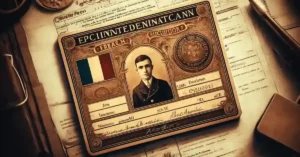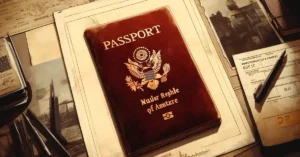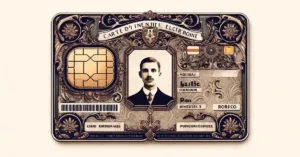Verifying a person’s identity is necessary in many sectors to prevent fraud and identity theft.
Passports are widely used documents for this purpose and include several security features. So, how to verify a Spanish passport online and ensure the presented document is authentic? The answer is in this article!
Need more information on how to verify the authenticity of your ID documents ? Check out our comprehensive guide to verifying ID documents, which includes all the resources available !
Check 1: General Appearance to Verify a Spanish Passport Online
The first step to verify a Spanish passport online when you have access to the original document is to check its overall appearance: it must show no signs of cutting, peeling, modification, or correction.
Pay particular attention to the area on and around the photo.
Check 2: Read, Cross-check and Verify Numbers and Information on Spanish Passports
The second step to verify a Spanish passport online is to ensure the consistency of the information on the document.
Document Number
The document number can be found in two different places: top right on the front, and at the start of the second line of the MRZ.
Both must be identical:
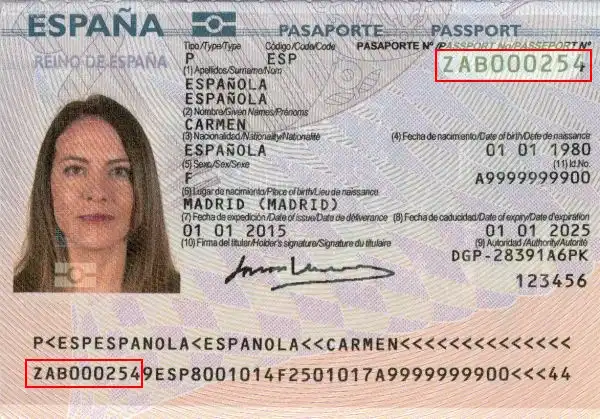
Date of Birth
The holder’s date of birth can also be found in two distinct places: in the middle of the front and in the middle of the second MRZ line in the format YYMMDD:
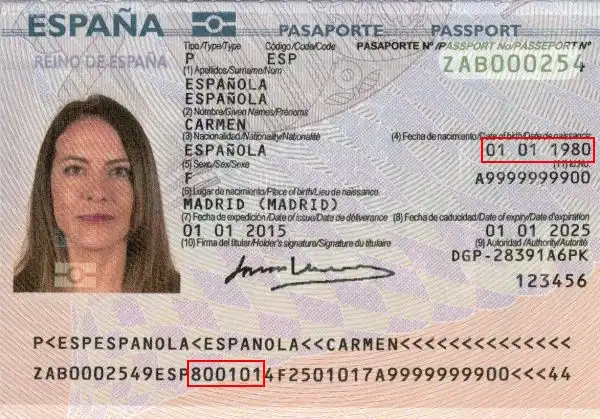
Surname and Given Names
Similarly, the surname and given names can be found on the document and in the first MRZ line:
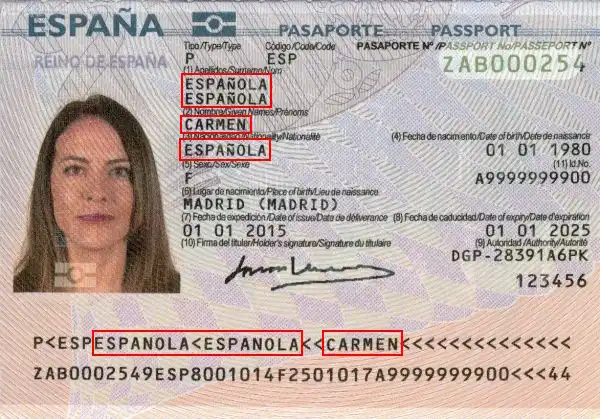
Holder’s Gender
The holder’s gender is indicated by “M” for male and “F” for female. This information is found on the front and in the second MRZ line:

Document Expiry Date
Another element present twice on the document is the expiration date, found on the front and in the second MRZ line in the YYMMDD format:

Issuing Country
The issuing country can be found in two places on the document: at the top of the front and at the start of the first MRZ line.
Nationality
The holder’s nationality can be found in the second MRZ line in ISO 3166-1 format:
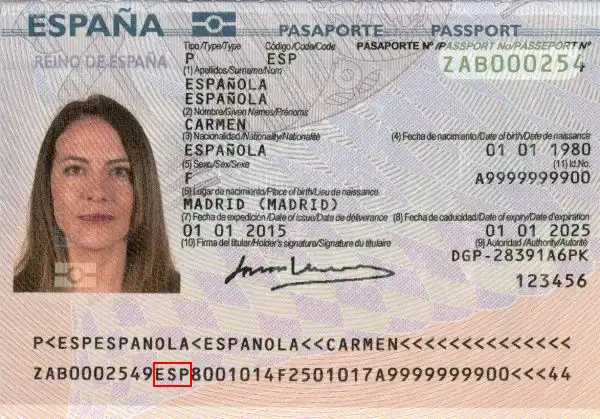
Check 3: Verify a Spanish Passport Using its MRZ
The lower part of the Spanish passport consists of two lines that repeat the information found on the document, along with check digits that prevent reading errors or falsifications.
Structure of the Spanish Passport MRZ
First Line

- Document Type: 2 characters, code indicating the type of document, represented by the letters “P<“.
- Issuing Country: 3 characters, the ISO 3166-1 alpha-3 code of the issuing country.
- Surname(s): the holder’s surname(s), separated by a “<” character.
- Given name(s): the holder’s given name(s), separated from the surname by two “<” characters and separated between them by a “<” character.
Second Line

- Document Number: 9 characters, the passport number printed on the document.
- Check Digit: 1 character, check digit of the document number.
- Nationality: 3 characters, holder’s nationality.
- Date of Birth: 6 digits, holder’s date of birth in YYMMDD format.
- Check Digit: 1 character, check digit of the date of birth.
- Gender: 1 character, holder’s gender (“M” or “F”).
- Expiration Date: 6 digits, passport expiration date in YYMMDD format.
- Personal Number: 11 characters, holder’s personal number.
- Check Digit: 1 character, check digit of the personal number.
- Check Digit: 1 character, check digit of the concatenation of characters from line 2 positions 44-54, 57-64, and 65-87.
Verify a Spanish Passport Using the MRZ Security Keys
A Spanish passport has 5 check digits (or security keys) that validate the preceding information.
They help prevent transcription errors or intentional/unintentional modifications.
How Does the Algorithm Work?
The algorithm used to create and validate the check digits is common to all identity documents: characters have a weight, which is multiplied by a factor depending on their position in the string (7, 3, and 1).
Digits have their numeric value (“0” is 0, “1” is 1, up to “9” which is 9), the chevron “<” also has a value of 0, while letters start at 10 for “A”, 11 for “B”, up to 35 for “Z”.
Example
Let’s take as an example the check digit for the date of birth from the specimen above.
The character string to validate is: “800101”.
To calculate the check digit, proceed as follows:
– “8” has a value of 8 and is in the first position, so multiply by 7: 8 * 7 = 56
– “0” has a value of 0 and is in the second position, so multiply by 3: 0 * 3 = 0, add to previous 56, total 0 + 56 = 56.
– “0” has a value of 0 and is in the third position, so multiply by 1: 0 * 1 = 0, add to previous 56, total 0 + 56 = 56.
– “1” * 7 = 7 and 7 + 56 = 63
– “0” * 3 = 0 and 0 + 63 = 63
– “1” * 1 = 1 and 1 + 63 = 64
The total is 64, from which we take modulo 10 (the remainder of the Euclidean division by 10), keeping only the last digit, which is “4”.
Our check digit is therefore valid because 4 appears on the document!
Individuals, do you occasionally need to verify one or more identity documents ?
Professionals, do you need to integrate proof of identity validation into one of your business processes, including all European identity cards and global passports ?
Check 4: Security Features to Verify the Authenticity of a Spanish Passport
An identity document contains various elements that help validate its authenticity.
This is the final and longest step to verify a Spanish passport online: we will review the different security features present on the pages of the Spanish passport.
Inside Front Cover (Beginning of the Passport)
Inside Back Cover (End of the Passport)
Biographical Data Page
Watermark
Protects vital information (photo, MRZ); the film secures the photo and reveals any attempt of scraping.
Security Film
National pictograms & micro-letters visible from different angles.
Inside Page
Iris printing makes faithful color photocopying impossible.
The ghost image links the identity and the page.
Printing Process
The color-shifting OVI is a premium feature difficult to replicate.
Conclusion
You now have all the keys to verify a Spanish passport online and ensure it is authentic!
No special equipment is required: with a little vigilance and time, you can avoid most of the frauds you may encounter daily!
You can also use our service which performs the checks in seconds via our web application: the results are available directly in the app and as a PDF report!
Individuals, do you occasionally need to verify one or more identity documents ?
Professionals, do you need to integrate proof of identity validation into one of your business processes, including all European identity cards and global passports ?










